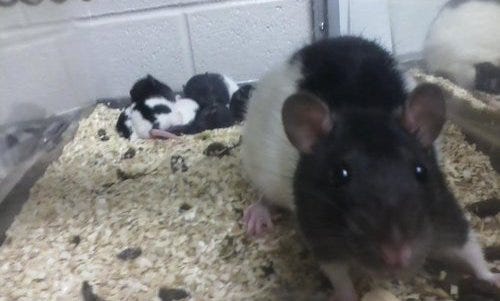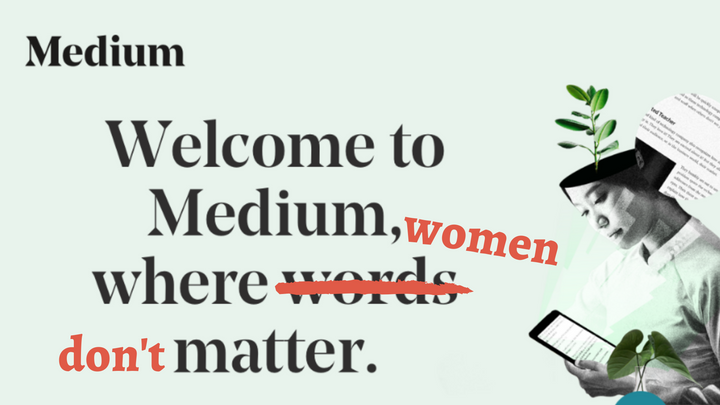Can Female Lab Rats be Victims of Patriarchy, Too?
My experience torturing and killing mothers for science

As an undergrad at Ithaca College, I was awarded the opportunity to conduct an original research study over the summer of my Junior year. I was thrilled to have an opportunity that most undergrads don’t get. The research would look amazing on grad school applications, and I thought working in my school’s behavioral neuroscience lab with rats would be fun.
But, in reality, I was signing up for one of the most traumatizing experiences of my life (you can read more about that here). I participated in the torture of murder of animals, and eventually left the lab without publishing my study due to ethical concerns. I still have nightmares about the things I saw and did.
Now, looking back on my experience with animal testing through a feminist lens, I am struck by how often one key part of the debate is ignored: the reproductive rights of the female non-humans involved. In fact, female animals provide the lifeblood of the vivisection industry.
My work, in particular, focused on examining the effects of something called a “maternal separation protocol.” This was a method to induce in young rats a life experience comparable to early childhood trauma, such as parental neglect or abuse. The ultimate goal was to study the impact of this experience on adulthood behaviors (alcoholism and aggression, for example). This protocol involved taking newly born pups away from their mothers for three hours a day. It was intended to be traumatic to the pups — being deprived of maternal care and affection has been found to have lasting long-term effects.
But I was interested in studying the impact this protocol had on the collateral victims: the mothers. How did the new mothers feel about this forced separation protocol? Was it just as traumatic for them?
“Female animals provide the lifeblood of the vivisection industry.”
Although I ended up leaving the lab before publishing my work, pilot studies demonstrated that, yes, this separation was traumatic for the mothers as well.
I didn’t really need data analysis to tell me this, though. Every day as we forcibly removed the babies from their mothers the mothers fought me, cried, and screamed as they watched their pups taken away from them. It was clear they did not want this.
While what we did to all of rats in this lab in the name of science was clearly torture and unethical by any anti-speciesist standard. The particular oppression that the female rats experienced was unique, though, and draws a direct parallel to how human women are controlled and abused for their ability to reproduce, often just as pawns in the patriarchy.
The primary test subjects in our lab were the male rats, so females were used purely as accessories and tools to achieve our end results. Most females started out being used as a mate for a male. This mating process prompted the male to become more aggressive when another male entered his territory — which made for strong statistical effects (what every researcher wants). The female was subjected to life in a lab “shoebox” container with no freedom, playtime, or socialization with anyone except her mate just so that the male would become more aggressive.
When she eventually became pregnant, her own time under the microscope would begin.
“If a female failed to reproduce in a reasonable amount of time, she was considered defective and would be killed.”
My lab only had to buy rats once or twice from lab rat breeders to get up and running. Otherwise, the lab was self-sustaining. Despite the fact that we were regularly killing hundreds of rats, we kept breeding more and more — using the females like machines, getting them pregnant as soon as they were able. She, of course, had no choice in this process. Unlike in nature where she could more freely choose her mate, we randomly assigned mates and stuck them in the same shoebox together. She had nowhere to run or hide and, eventually, the male would dominate her. The screeches of pain coming from the mating room made it clear that this was not an act that she usually wanted. If a female failed to reproduce in a reasonable amount of time, she was considered defective and would be killed.
When a litter of pups was born, the male was removed from the box (male rats have been known to cannibalize their babies). This is when the maternal separation protocol began, with her babies becoming the next generation of subjects. If the pup was a male, he would go on to be one of the aggression test subjects. If she was female, she was doomed to the same fate as her mother before her.

Litters participating in the maternal separation protocol had to all be the same size, otherwise, there would be a confounding variable. Most rat litters ranged between 8–12 pups, so litters were “culled” down to six. This involved cutting the heads off of live newborns with scissors. Despite the fact that I was studying the impact of maternal separation on mothers, the impact of this culling process on maternal well-being was not considered at the time.
Most mothers were “euthanized” shortly after the study on her litter was complete, and the cycle would begin again with her female daughters.
These mothers were treated as baby-making machines, and a mere inconvenience to the primary research happening in the lab — collateral damage in the war on human trauma and aggression. Despite having to complete an Internal Review Board ethics audit prior to conducting this research, the effect of the forced mating, litter culling, and maternal separation protocol on the mother was never considered. Their pain was not only ignored but completely unnoticed as we focused on the male test subjects, who would make up the stats and figures in our eventual paper.
“Their pain was not only ignored but completely unnoticed as we focused on the male test subjects, who would make up the stats and figures in our eventual paper.”
Females of all species are oppressed for our ability to reproduce. This is the root cause of patriarchy and the driving force behind misogyny. “Forced breeding happens everywhere non-humans are abused, from farms to pet stores.”
Animal rights activists have long recognized the connection between feminism and the dairy and egg industries as these two industries clearly abuse the female reproductive systems. Beyond these clear examples of female exploitation, though, lie industry after industry built on the backs of females being used as reproductive machines.
Vivisection is not the only field in which this occurs. Forced breeding happens everywhere non-humans are abused, from farms to pet stores.
In human populations, forced breeding can also look like child marriage, lack of access to birth control or abortion, and cultural norms that pressure women into pregnancy.
Society regularly pressures women into reproducing so that a male-dominated world can continue to have men to fight its wars and produce its labor. The girls are afterthoughts, doomed to follow the same oppressive cycle of her mother and grandmother before her.
At the same time, “undesirable” groups of women are often encouraged (or forced) to stop reproducing by white, western, patriarchy which wishes to control women’s bodies as a means of controlling certain populations. Michelle Goldberg’s The Means of Reproduction examines how the West has exported reproductive control to achieve their own financial, moral, or racial goals.
Women’s reproductive capacity, and male attempts to dominate and control it, have been at the heart of women’s oppression — and any attempts to create a liberated world for women must address this.
Perhaps examining how non-human females are used and abused in similar ways can help us get to the root cause of patriarchy: female reproductive power.
The generous support of our readers allows 4W to pay our all-female staff and over 50 writers across the globe for original articles and reporting you can’t find anywhere else. Like our work? Become a monthly donor!
Enter your email below to sign in or become a 4W member and join the conversation.
(Already did this? Try refreshing the page!)




Comments